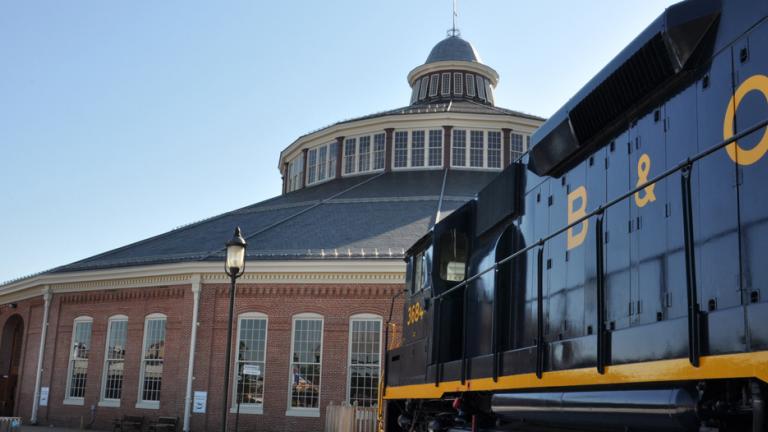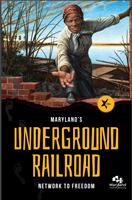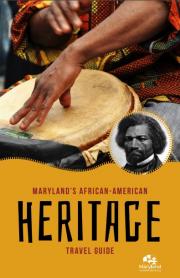
Discover African-American History in Maryland
Come discover Maryland’s rich and remarkable African-American history.

From the founding of the colony through today, Maryland has been shaped by African-Americans. The story of their experience is one of perseverance, courage, and triumph, from the horrors of enslavement, to the heroism of the Underground Railroad, the innovation of the Jazz Age, and inspiring contributions to art, science, and culture.
Journey through Maryland, the Most Powerful Underground Railroad Storytelling Destination in the World, and honor the lives of American heroes like Josiah Henson, Frederick Douglass, and Harriet Tubman. Celebrate the people, the progress, the art, and the inspiration of these African-American stories in Maryland.

Harriet Tubman is a true American hero and an inspiring figure whose legacy is synonymous with the fight for freedom around the world. Drive the one-of-a-kind Harriet Tubman Underground Railroad Scenic Byway to explore the secret network of trails, waterways, and safe houses used by enslaved people fleeing north to escape slavery, and visit sites along the byway where Tubman's remarkable life created an enduring legacy. Download the award-winning Harriet Tubman Underground Railroad Byway audio tour and mobile app to guide you along your journey.

Undoubtedly one of America’s most prominent and influential orators, abolitionists, and statesmen, Frederick Douglass was an essential chronicler of the experience of African Americans caught in the grips of slavery and an unstoppable force in ending this national evil. Frederick Douglass was born on a farm on the Eastern Shore and later escaped to freedom from Baltimore, but returned in his later years to share his message of equality and continue his fight for civil rights. Discover the real Frederick Douglass in the places that shaped him on a driving tour that starts on the Eastern Shore and takes you through Annapolis and Baltimore.

The National Park Service’s “Network to Freedom” celebrates the stories, commemorates the legacies, and preserves the places along the Underground Railroad. Maryland’s landscape is dotted with Network to Freedom sites where hundreds of freedom seekers risked all to escape slavery. More people successfully fled from bondage in Maryland than any other state. Honor their stories filled in equal measure with bravery and inspiration.

An affiliate of the Smithsonian, this 82,000-square-foot museum located in Baltimore’s walkable Inner Harbor offers an incredible vista on the African-American experience in Maryland. With collections honoring the African-American experience in the military, early jazz age recordings, Maryland community history, and events year-round including special Black History Month celebrations and commemorations, the Reginald F. Lewis Museum of Maryland African American History & Culture is a true must-visit.

Maryland’s official museum of African-American heritage, the Banneker-Douglass Museum documents, interprets, and promotes African-American history and culture. A permanent exhibit, “Deep Roots, Rising Waters: A Celebration of African Americans in Maryland,” provides an overview of African-American history from 1633 through today. Explore stories of Mathias De Sousa, Maryland’s first African-American settler and elected representative; Thurgood Marshall, the first African-American Supreme Court judge; and Benjamin Banneker, who used his almanac as an anti-slavery protest in correspondence with Thomas Jefferson, and witness some of the ways African-Americans continue to shape our American culture.

This one-of-a-kind museum preserves the one-time home of Josiah Henson, the real life abolitionist, educator, author, and conductor on the Underground Railroad who inspired Harriet Beecher Stowe to write her groundbreaking novel, Uncle Tom’s Cabin. The museum features a truly unique and inspired gallery featuring modern graphic comic-book style sequential art to immerse visitors in the life and story of Henson who, after escaping from slavery with his family, founded a community for formerly enslaved people in Canada.

Tour nearly 30 sites in the Beaches, Bays & Water Ways Heritage Area on the Lower Eastern Shore. Take a journey of faith and freedom on this African American Heritage Driving Tour of homes, cemeteries, churches, schools and more that explore 300 years of history across rural and urban landscapes.

One of the nation's most dynamic cultural and educational institutions, the National Great Blacks in Wax Museum is also one of the most unique. Committed solely to the study and preservation of African-American history, the museum features more than 100 life-sized and life-like wax figures presented in dramatic historical scenes accompanied by special lighting, sound effects, and animations. Displays include Harriet Tubman, Benjamin Banneker, Billie Holiday, President Barack Obama, Thurgood Marshall, and many others. The experience is highlighted by a dramatic walk through of a replica slave ship and a frank and gripping history of the Middle Passage.

From 1880-1920, this two-acre tract of land served as the center of a largely African-American roadside community. On the site, both black and white residents sold produce and handmade items to travelers. Today, the park is a “Living History” museum where actor/interpreters along with historic furnishings and artifacts from the site offer a window into the lives of the people who lived there.

Set against the remarkable landscape of Blackwater National Wildlife Refuge and using architecture which both emulates the style of Tubman’s day while propelling visitors along a truly stirring journey of discovery, the Harriet Tubman Underground Railroad Visitor Center is an unforgettable place. Inviting visitors into a landscape little-changed since Tubman herself explored these same wetlands nearly two centuries ago, the visitor center offers an inspiring and deep look into the life of one of history’s greatest heroes and all of the people who worked to bring people out of bondage and into the light of freedom along the Underground Railroad.

This waterfront museum in Baltimore’s Fells Point neighborhood showcases the lives of Maryland natives Frederick Douglass and Isaac Myers, important contributors in African-American maritime history. Through a self-guided tour you’ll learn about Douglass’s time working on the docks as an enslaved child before escaping to freedom in New York, and about Myers, a free-born African-American labor leader and one of the founders of the Chesapeake Marine Railway and Dry Dock Company.

This Havre de Grace Maritime Museum’s exhibit entitled, “The Underground Railroad: Other Voices of Freedom” celebrates the stories of the Underground Railroad at the top of the Chesapeake Bay. With its winding waterways, freedom seekers utilized boats, barges, and their own wits and wisdom to navigate this region - the final gauntlet on the journey to freedom, so close to the North.

The park offers guided tours of the grounds and buildings that highlight the lives of enslaved peoples who once worked this 19th-century farm. Explore the on-site museum and manor house and walk the Underground Railroad Experience Trail that interprets the experiences freedom seekers had while escaping the bonds of slavery.

Trace the journey of African Americans, and explore their impact both nationally and internationally with Annapolis Tours℠ by Watermark®. Developed in partnership with the Kunte Kinte-Alex Haley Foundation and named a “Heritage Award Winner” by the Four Rivers Heritage Area, this two-hour African American Heritage walking tour starts at Market House Park across from Annapolis City Dock, where slave ships entered 300 years ago. The Alex Haley statue that marks the significance of the author of “Roots” and the journey of his ancestor Kunte Kinte are featured.

Moored in Baltimore Harbor and a proud symbol for the city, the USS Constellation was the last all-sail warship built by the U.S. Navy, and distinguished herself in the fight against the trans-Atlantic slave trade. She served as the flagship of America’s Africa Squadron from 1859 to 1861, just prior to the American Civil War. The war marks a well-known era in American history, and today the USS Constellation is open for tours, serving as an important reminder of the pre-war struggles of people, both enslaved and free, and the conditions that made the war and shaped the nation.

A gifted and largely self-taught mathematician, astronomer, almanac writer, surveyor, naturalist, and abolitionist during the late 1700s, the great Benjamin Banneker is considered by many to be the first African-American scientist. The Benjamin Banneker Historical Park & Museum highlights the accomplishments of African-Americans in science and other areas here, on the site where Banneker crafted one of the first American-made clocks, wrote his almanacs, and engaged in his famous correspondence with Thomas Jefferson.

Created by Destination Southern Maryland, this free guide takes visitors on a journey through African-American history, culture, and heritage in Calvert, Charles, and St. Mary’s counties, and features five sites on the National Underground Railroad Network to Freedom. Divided into three sections, the guide includes locations, contributing history, and notable figures relating to resistance and resilience, reconstruction and community building, civil rights, and economic prosperity.

This 90-minute walking tour, offered by Watermark Journey in partnership with the Kunta Kinte-Alex Haley Foundation, follows the journey of the young enslaved Freddy Bailey, who learned to read in what was then the busy ship-building area of Baltimore known as Fells Point. Here he was influenced and inspired to ultimately spread the word of the evils of slavery as the most famous abolitionist orator of his time. Arriving at the formative age of 8, he escaped from Baltimore to the north at 20. Walk the streets with a period-attired guide as you step back into the early 1800s and learn about the first book he purchased, the streets he lived on, the shipyards he worked for, and the houses he later purchased as a free man. (The Kunta Kinte-Alex Haley Foundation receives 20 percent of the proceeds.)

From the earliest days of the 18th century, the lives, sacrifices, and contributions of African-Americans have left an indelible impression on Washington County. With sites along the Underground Railroad, sports history featuring the great Willie Mays, and so much more, the tour is enlightening, enthralling, and essential.

Known as “Dr. Lillie” or even “Ma Jackson,” as founder of the Baltimore branch of the NAACP, Jackson earned her title, “The Mother of the Civil Rights Movement.” Galvanized by the last recorded lynching in Maryland, Jackson worked with Thurgood Marshall, Clarence M. Mitchell Jr., Juanita Jackson Mitchell, and other civil rights pioneers and legends in the fight for racial justice. In this Baltimore museum, you’ll meet this amazing woman and discover her accomplishments, from local to national victories that have changed the nation for all Americans.

Covering 147 acres of historic West Baltimore, the state recognized Black Arts District combines Baltimore’s rich history of African-American innovation and influence with the trend-makers of today. Dining, art, music, and so much more come together in this uniquely Baltimore, uniquely Black, uniquely beautiful place.

Home to more than 2,500 works of African art including its famous collection of figurative sculpture from western and central Africa, the BMA is home to one of the earliest and most important collections of African art in the U.S. More recently, the museum has made its mission to feature the works of contemporary Black artists including Glenn Ligon, Melvin Edwards, and President Barack Obama portrait artist Amy Sherald.

This 40-acre farm, set in the remarkably beautiful Seneca Creek State Park, is the region’s only living history center depicting 19th-century plantation life. Programs open a window into the lives of enslaved people and give visitors a sense of the dangers of self-liberation. The farm’s “Cemetery Walk” takes visitors through the hallowed ground of the Button Farm burial ground, final resting place of nearly a dozen unidentified enslaved people. Button Farm also offers programs focusing on team-building, conflict, the environment, and sustainability issues.

The B&O Railroad Museum celebrates and honors the contributions of African Americans to the railroad industry. Take in the exhibits and learn about the men and women who filled vital jobs along the Baltimore & Ohio Railroad's line and understand how significant social issues, such as segregation, affected railroading. Discover the stories of freedom seekers who escaped slavery using this rail line. Explore the immersive exhibit The Underground Railroad: Freedom Seekers on the B&O to discover their stories.

One of the best preserved African-American schoolhouses in the nation, this one room building invites visitors to witness the struggle of St. Mary’s County’s African-American community during segregation.

“A Home for Black Excellence,” the Prince George’s African-American Museum & Cultural Center makes its mission to celebrate and inspire the community by preserving, presenting, and above all, cultivating the cultural and artistic contributions of African-Americans in Prince George’s County and beyond. In an era of digital experiences, the museum prides itself on its physical collection of important artifacts. The center also hosts “Community Treasure Chests” around the area, an oral history initiative designed to discover the history hidden in our own backyards.

Catoctin Furnace historic site in Frederick County provides a rare glimpse into the lives and skills of enslaved artisans who created iron products for the Revolutionary War effort and crafted the beautiful stoves that graced Maryland's mansions. The African American Cemetery Interpretive trail links the museum to the furnace ruins and provides an engaging and informative walk through the village to the Museum of the Ironworker. A highlight of the museum are two forensic facial reconstructions of enslaved workers. Left out of the written record in name and deed, the individuals are revealed within the archaeological record. Now, the art and science of forensic facial reconstruction allow you to meet them.
More about African-American Heritage
Network to Freedom Guide
Network to Freedom Guide

Maryland's Underground Railroad Guide
African-American Heritage Guide
African-American Heritage Guide

Maryland's African-American Heritage Guide







